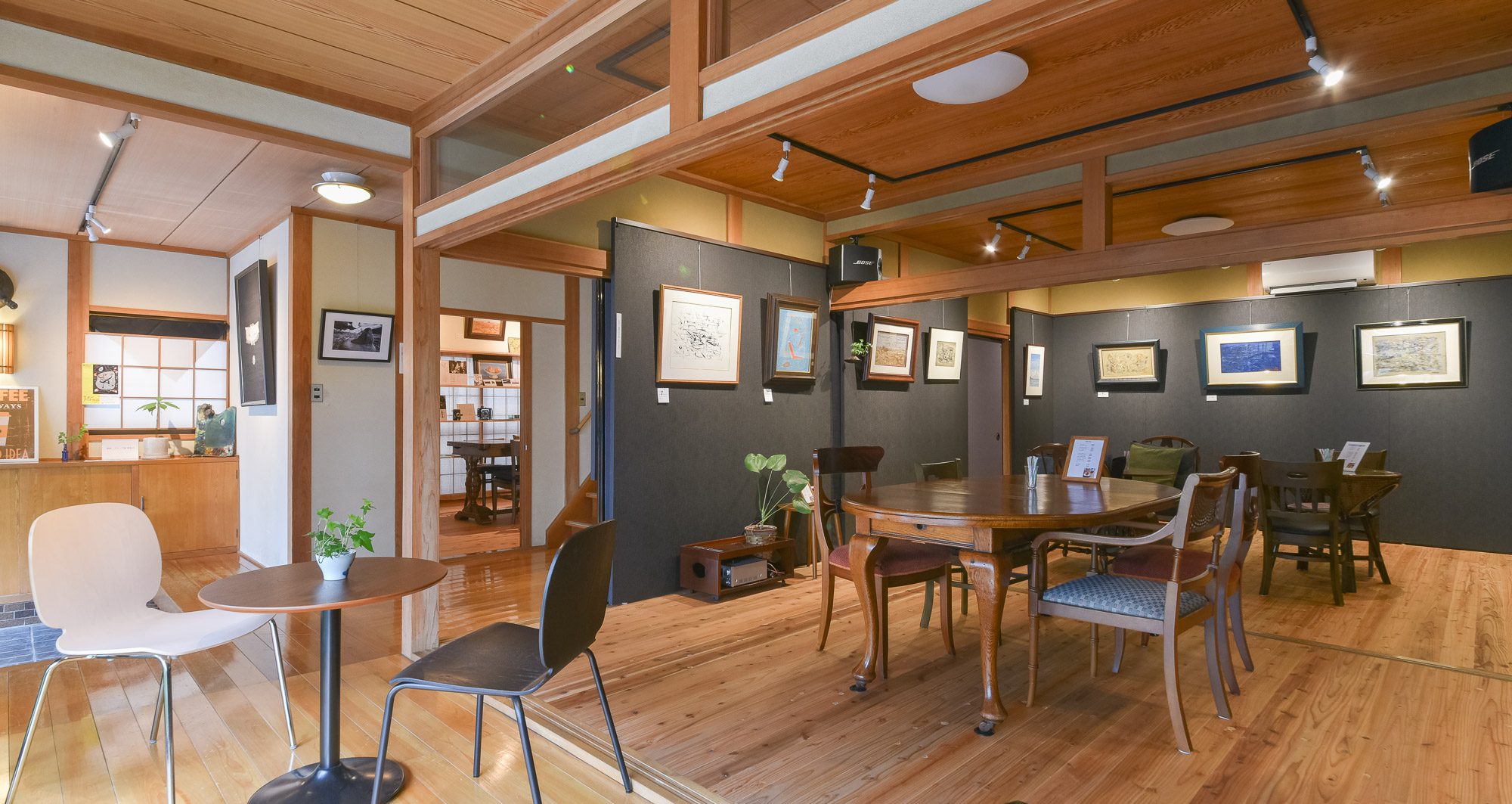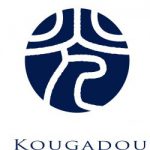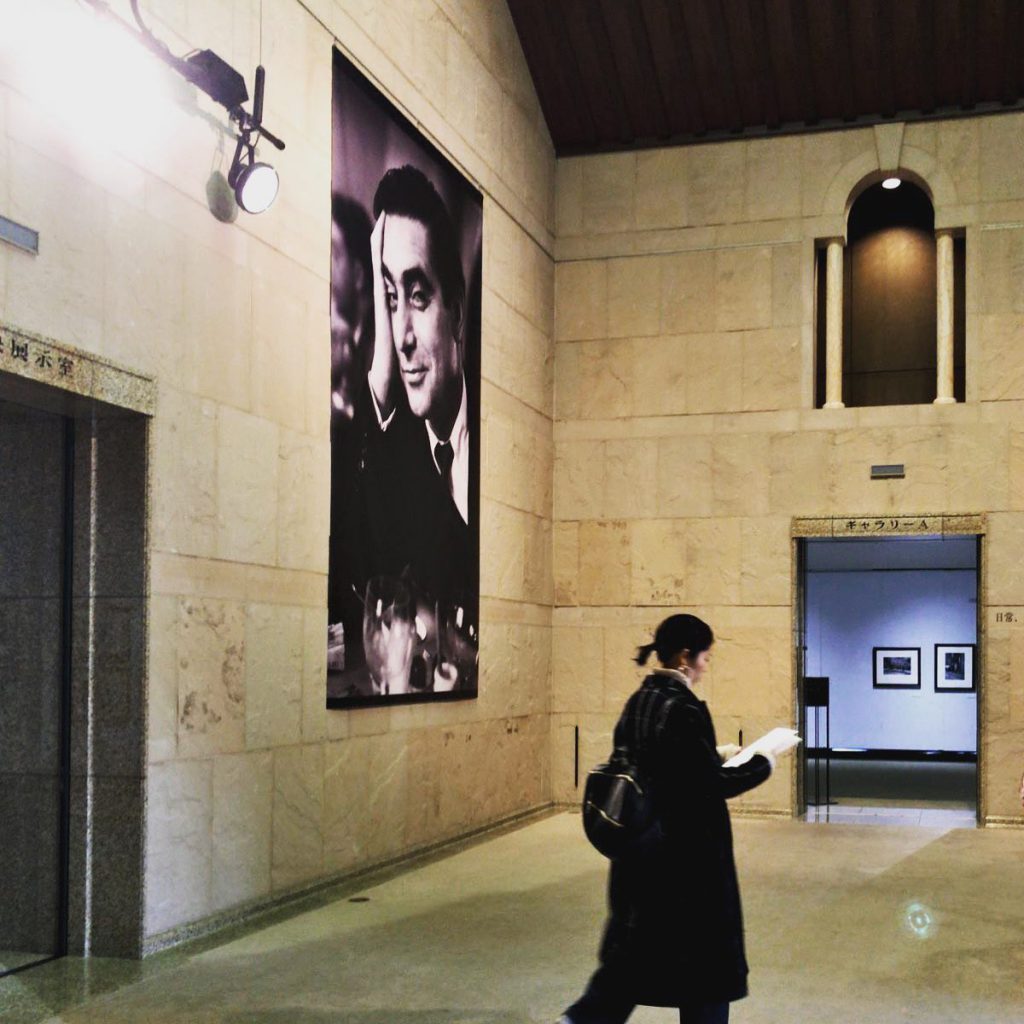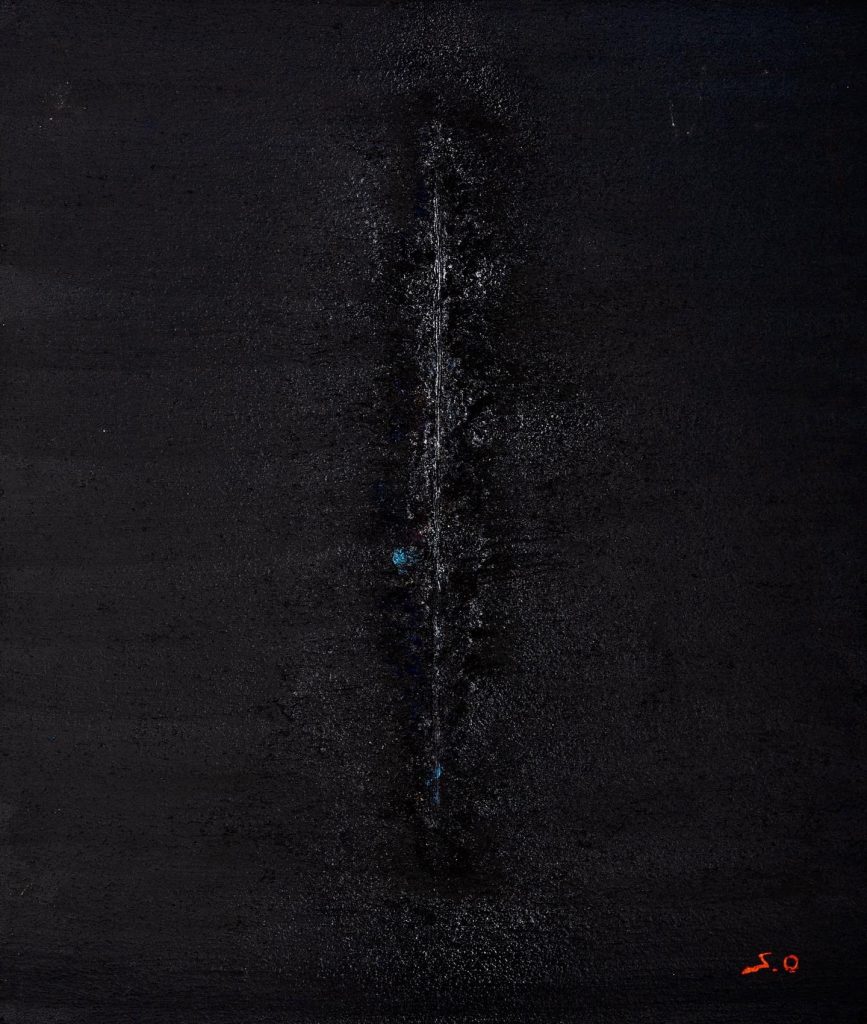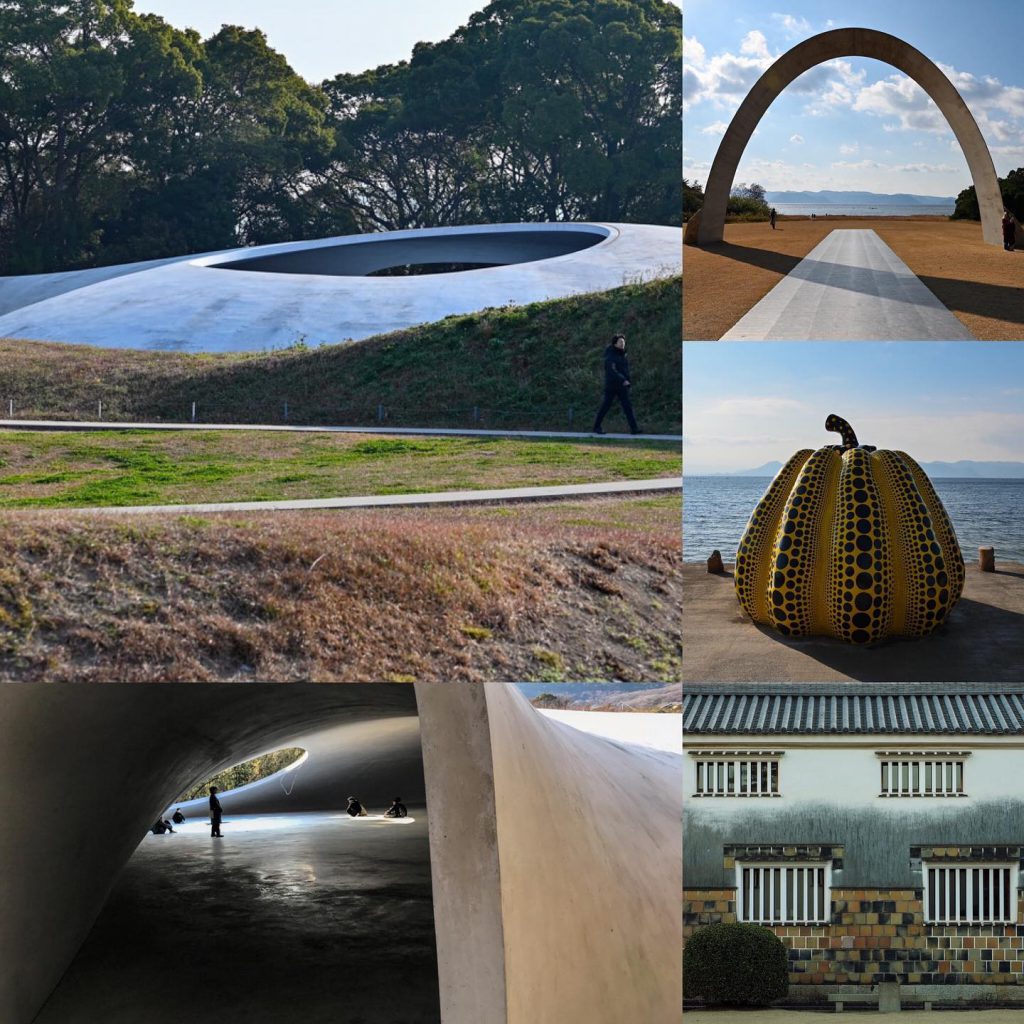ロバート・キャパ展 -THE FACE-
田川市美術館
戦争写真家(報道写真家)のイメージが強いキャパですが、平時の人物写真や子どもの笑顔を撮った写真などにも素晴らしいカットがたくさんあります。
1/26まで。
「海の風景」2001 F10
「海の風景」2001 F10 尾花成春
2001年11月に福岡市天神のアートスペース貘で個展を開いた際、読売新聞に掲載された個展評をご紹介します。
元九州派のこの作家はここ10年ほど黒一色の絵を描き続けてきた。合板のパネルに漆喰を塗り、あるいは海岸の細かい砂を敷き詰めて下地を作ったうえに、油絵の具を何重にも塗り重ねる。光沢のない独特の色調は絵の具が漆喰や砂に吸収されることから生じ、部分的に見られる灰色がかったむらは塗った絵の具を金属のヘラでこすり取った跡だ。
おおむね水平に引かれた筆の痕跡も露に残されており、黒一色と言ってもそこには変化に富む微細なニュアンスがちりばめられている。
ミニマリズムとの表面的な親近性に目を奪われて、画面からニュアンスや表情が消し去られていないことを不徹底と見るなら、作品理解の糸口はふさがれてしまう。この作家の黒はモダニズムの還元主義とは全く別の文脈から生まれたものだからだ。
自宅の庭の土をテーブルに盛っただけのものを、「筑後平野」と題して、美術館で発表したのは1970年のこと。以来、この人の手がけてきた形式の上では、抽象の仕事と見える作品はすべて本質において風景の写実だったと言うことができる。
抽象的写実といえば、形容矛盾であるようだが、対象の持つ具体性のリアリティを殺さずに世界を一枚の絵画に再現するという途方もない企てを遂行するには「一即多」というような非論理の論理によるしか道はないだろう。世界を抽象するその仕方自体がモダンな抽象とは違っているのである。
黒の画面を前にして、なにか禅問答を挑まれているような気持ちになるのは、おそらくそいう事情による。草木虫魚に至るまで世界の一切を包み込んで生きさせる豊穣な黒、ということができるだろう。(人)
Shown below is a review in the Yomiuri Shimbun of an exhibition held at Art Space Baku in Tenjin, Fukuoka, in November 2001:
“This former The Kyushu school painter has been painting in solid black for the last 10 years. He applies stucco or spreads the fine sand of the shore over plywood panels to make the groundwork and oil paints in layers. Here, the unique matte color results from the paint being absorbed into the stucco and sand, while the grayish streaks are traces of the paint scraped away with a metal spatula.
While all in black, the painting contains not only clear traces of the brush drawn more or less horizontally but varying delicate nuances of the color in places.
If, fooled by the seeming affinity it appears to have with minimalism, you see the outward nuances and expressions that remain unerased on the picture plane as a sign of its incompleteness, the clue to understanding the work will be lost on you. For this artist’s black is completely different in its origin from its modernist reductionist counterpart.
It was back in 1970 that he presented a piece of soil from the garden at his home simply placed on a table and entitled the “Chikugo Plain” at an art museum. Thus, all ensuing works that looked like abstract works could be essentially described as realistic representations of landscape in all forms ever attempted by the artist.
To speak of abstract realism seems to be a contradiction in terms but the only way to make a tremendous attempt to reproduce the world in a single painting without deadening the reality of its objects in all their concreteness would involve an illogical logic, such as ‘one is many’ characteristic of the Buddhist worldview, whose approach to abstracting the world in itself is quite different from that in modern abstractionism.
This is probably how you feel like you are being challenged with Zen riddles in front of the black picture plane. Indeed, it can probably be best described as a fertile black that envelops and brings to life the whole world, including its plants, insects and fish.”
Thanks to Mr. Ito for translation.
「アートとデザイン展」開催中です @パトリア日田
昨日、パトリア日田で「アートとデザイン展」をみてきました。オープニングイベントで柳さんのライブペインティング。お年齢を感じさせないパワーみなぎるパフォーマンスでした。
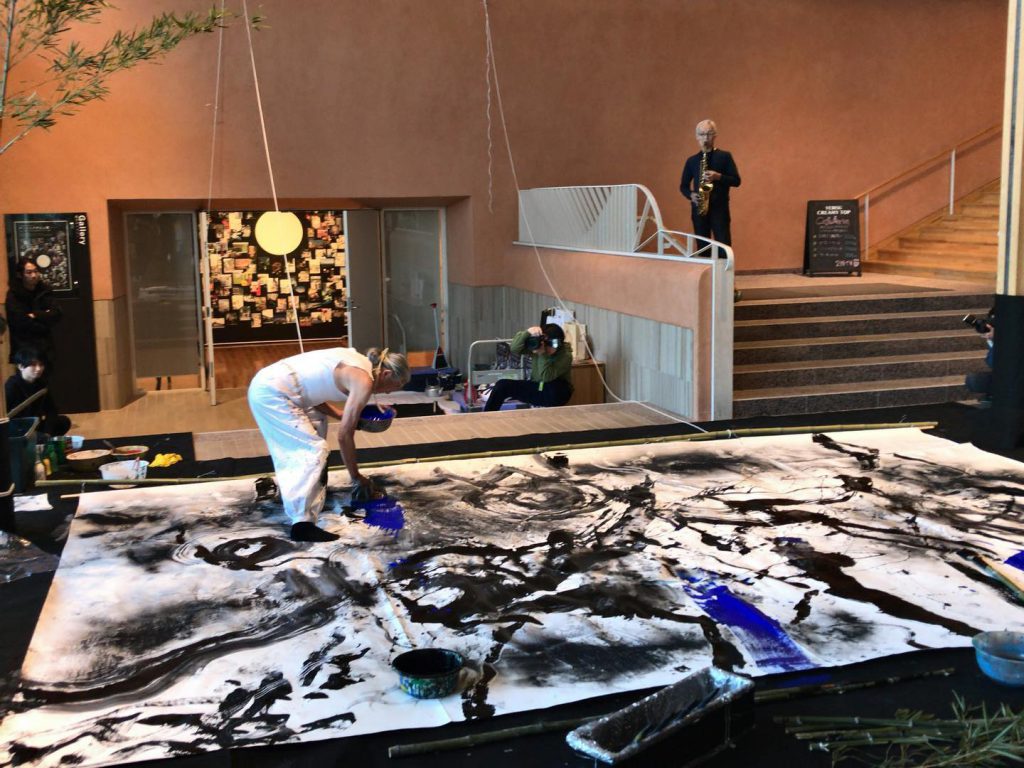
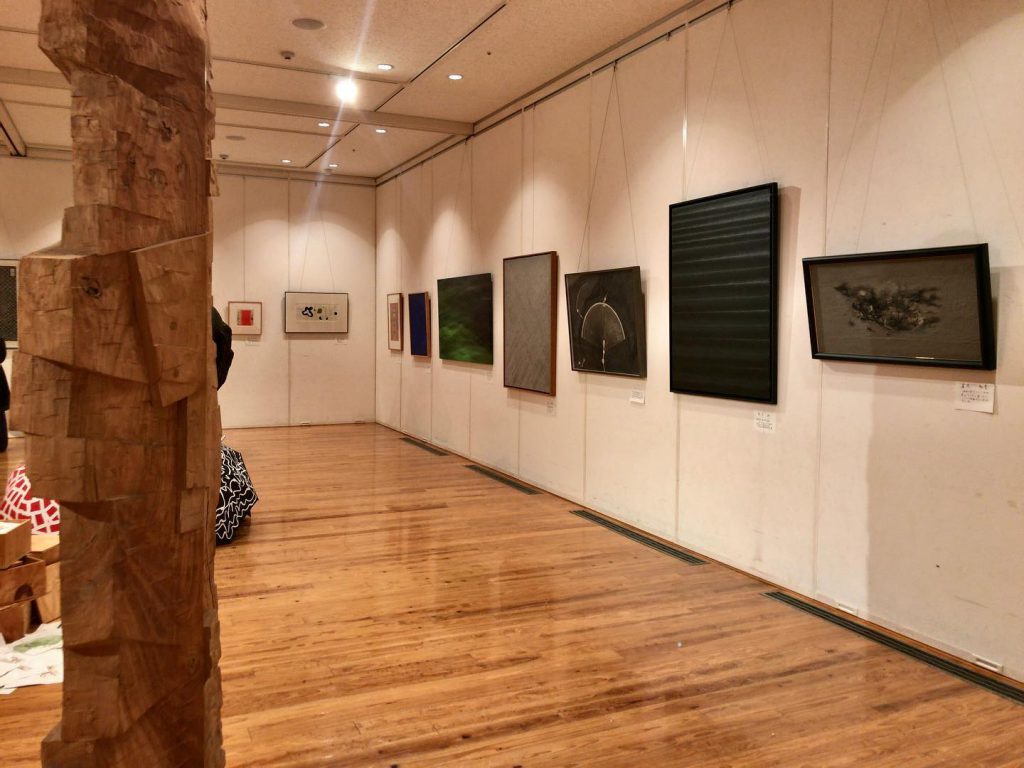

#アートとデザイン展 #共星の里 #尾花成春 #ヒタスタイル @ パトリア日田
ひっそり「九州派」を通す 1998.12
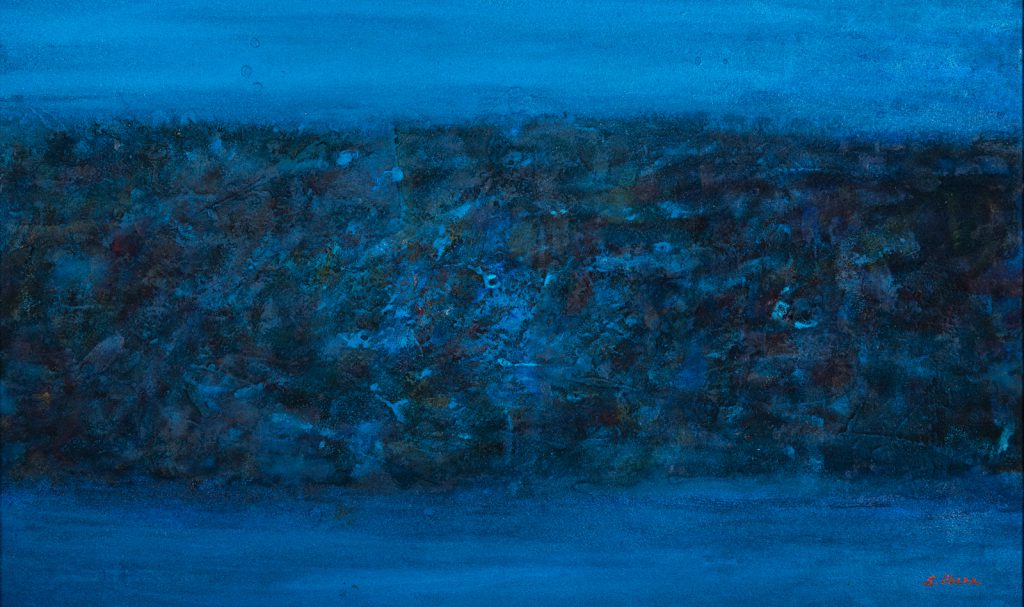
「海よりの風景」1995 1,000×600
尾花成春は1998年11月に福岡市天神のアートスペース貘で「海より」と題する個展を開いています。その時、読売新聞の小林清人氏(現在は退社?)に受けたインタビューが残っていました。1998年12月5日の夕刊に掲載されたようです。その時の絵への向き合い方、九州派時代の己の立ち位置など、画家の内面の片鱗が伺えるとてもいい記事なので紹介したいと思います。
読売新聞 夕刊 1998.12.5
「インタビュー」
タイトル ひっそり「九州派」を通す
サブタイトル 漁村や山村にこそ反応がある
このところ、長崎県平戸市の漁村や福岡県宝珠山村など辺鄙な場所で発表してきた元九州派のベテランが約10年ぶりに福岡市で個展を開いている。「もう死んだかと思われているかもしれないから、画廊から誘ってもらったのを機に久しぶりに都会で」ということだそうだ。海の砂や煤、漆喰などで描いた静謐なモノクロームの絵画を通して、九州派の精神を粘り強く実践しているらしい画家の現在をかいま見ることができる。
なぜ、漁村や山村を選んで発表するのですか。
「今さら、ちゃんとした会場で発表することもなかろうと。地方分権などと言いながら、結局は中央思考ですよ。みんな都会を目指している。ぼくは消費社会の中に身を置きたくないというか、ひっそりと自分を追求したいと思っている。平戸の根獅子地区の場合、市の中心部から24キロも離れているんです。初めて絵を見るというような人ばかりなんですが、逆にこちらは真剣勝負ですよ」
どんな風に反応が違うのですか。
「都会なら反応を計算できるし、計算する自分のいやらしさみたいなものも感じてしまう。誘われて現地を見て、湧いてきたイメージを絵にするのですが、ぼくの絵は抽象でしょう。何を描いているのかわかるはずがないのですが、『わかる』と言われるのです。『これは平戸だ』と。言葉にはなりませんよ。でも、通じていることがわかる。都会で絵が売れたとか、評判がよかったというより、もっと真実の喜びがある」
「根獅子は四日間の会期中、地元の人がテントを張って、ぼくのために炊き出しをしてくれた。ぼくが絵を教えている人の中に九響のメンバーが五人いて、公民館で室内楽をやってくれました。クラシックなんて縁のない人たちが相手ですが、唱歌や童謡みたいなものはやって欲しくない。で、ドビュッシーを昼夜二回演奏してくれたんです。昼来てたおじいさんが夜は最前列で聴いていました。『難しいのはわからないだろうから、わかりやすいものを』と考えるのは間違いです」
内陸部で生まれ育った尾花さんがここ十年ほど海をテーマに描いている。
「筑後川のシリーズを長く続けていて、新しい世界を作りたかった。最初は瀬戸内海に行ったんです。屋島の高台から眺めているうちに、歴史とか人間の営みとか、ぼくの育った筑後の内陸部の様子と通じ合うものがあると思った。国東半島をはじめ大分の海はくまなく回りました」
海岸の砂をふるいにかけ、フライパンで焼いて殺菌したのを、ボンドでベニヤ板に接着して下地を作る。黒の部分には国東の砂を使い、油煙(煤)を塗っている。白の部分は平戸の砂の上に漆喰だ。画材を買えなくて、コールタールなど身近にある安価な素材を活用したという九州派時代を思い出させる話だ。
「漆喰は一俵いくらで安上がりだし、質感がいい。砂の配合でいろんな白を出せる。何か材料にならんかと探す習性はたしかに九州派時代からのものでしょうね」
目立ちたがり屋の印象が強く、中央の権威にかみつきながら、どこかで中央に流し目を送っていた観のある九州派の中で、尾花さんは独特の位置を占めていたように見える。
「九州派のエネルギーは外に向かっていましたが、ぼくの場合、自分のための九州派だった。自分を変えるために九州派が必要だった。人がどう思おうが、どう見ようが、無駄な労力を惜しまずに、やりたいことをやる。そういう前衛的なあり方が九州派の原点だったわけで、単なる目立ちたがり屋の集団ではなかった。周囲に騒がれて調子に乗ったいう一面はありましたが」
「ぼくとか、今度福岡県立美術館で回顧展のあった宮崎準之助さんなどは冷めているところがあって、九州派からいいものだけをもらったという感じがします。あの訳のわからないエネルギーは自分にはないものでしたから」
「世の中も美術界もだめになるだけなった」と言う。まだだめになっていないものを探すために漁村や山村へと尾花さんは足を向ける。「自分を貫きたいなら独りでやるしかない。田舎にいても怖いものは何もない」という言葉は、九州派を原点にした自分の歩みへの確かな自信から出た言葉だろう。
個展は六日まで、福岡市中央区天神3-4-14、アートスペース貘で。
(文・小林清人)
Shigeharu Obana has a solo exhibition entitled “From the Sea” at the Art Space Baku in Tenjin, Fukuoka in November 1998. At that time, there was an interview left with Kiyoto Kobayashi of the Yomiuri Shimbun (now leaving?). It appears to have been published in the evening edition of December 5, 1998. It is a very good article that gives a glimpse of the artist’s inner glimpses, such as how to face the picture at that time and his position in the Kyushu school era.
Recently, a former Kyushu veteran who has been presenting in remote places, such as a fishing village in Hirado City, Nagasaki Prefecture and Housyuyama Village in Fukuoka Prefecture, has held a solo exhibition in Fukuoka City for the first time in about 10 years. “It may be thought that I have died, so in the city after a long time after being invited from the gallery,” he said. Through the serene monochrome paintings drawn with sea sand, soot, and plaster, you can see the artist who seems to persistently practice the spirit of the Kyushu school.
Why do you choose to open an exhibition in a fishing village or mountain village?
“I don’t think we’ll be presenting at the right venue anymore.Even when they say decentralization, they are thinking centrally in the end.Everybody is aiming for a city. I don’t want to stay in a consumer society. In the case of Hirado’s Neshiko district, it’s 24km from the center of the city. There are people who look at the picture for the first time, but on the contrary I am serious.”
How are their reactions different?
“I can calculate the response of the viewer in a city, and I may feel nauseating to do so.I am invited to look at the site and draw the image that springs up, but my picture is abstract. They can’t tell what I’m drawing, but they say “I understand.” “Indeed, this picture represents our land.” They cannot be explained in words. But I know they understand.I had more true gratification than selling a picture in a city or having a good reputation. ”
“During the four-day exhibition, locals set up tents and cooked for me. There were five members of the Kyushu Symphony Orchestra who taught me paintings, and they performed chamber music at a public hall.The villagers are not interested in classical music. But I don’t want them to play songs and nursery rhymes. So they played Debussy twice a day and night. The old man who came to listen in the daytime was listening in the front row at night. It’s a mistake to think of something that’s easy to understand because you won’t know it’s difficult. ”
Obana, born and raised in the inland, has been painting on the theme of the sea for the past decade.
“I’ve been painting on the Chikugo River series for a long time and wanted to create a new world. At first I went to the Seto Inland Sea. Looking from the hill of Yajima, I thought that the history and human activities were the same as in Chikugo where I grew up. I went all over the Oita sea including Kunisaki Peninsula. ”
The sand from the coast is sifted, baked in a frying pan and sterilized, and then glued to the plywood with a bond to make the groundwork. The black part is made of Kunisaki sand and painted with soot. The white part is plastered on the sand of Hirado. It reminds me of the Kyushu school era, where I could not buy art supplies and used inexpensive materials that were nearby, such as coal tar.
“Plaster is cheap and has a good texture. Various whites can be generated by the composition of the sand. The habit of searching for something is definitely from Kyushu school days era. ”
Obana seems to have occupied a unique position in the Kyushu school, which had a strong impression of a conspicuous shopper and clung to the authority of the center, but had been drifting somewhere in the center.
“The energy at the Kyushu school was outside, but for me it was going to my inside. I needed a Kyushu school to change myself. It wasn’t just a stand-out group because the avant-garde way of doing things was the starting point of the Kyushu school. I did
“I and Junnosuke Miyazaki, who opened a retrospective at the Fukuoka Prefectural Museum of Art, have a calm place and I think we received only good things from the Kyushu school. Because there was nowhere else.”
“It has only spoiled the world and the art world,” he says. Obana turns to fishing villages and mountain villages to look for things that have not been spoiled yet. The word “I have to do it alone if I want to penetrate myself. I’m nothing afraid even in the countryside” is a word that comes out of his confident confidence in his steps that originated in the Kyushu school Would.”
